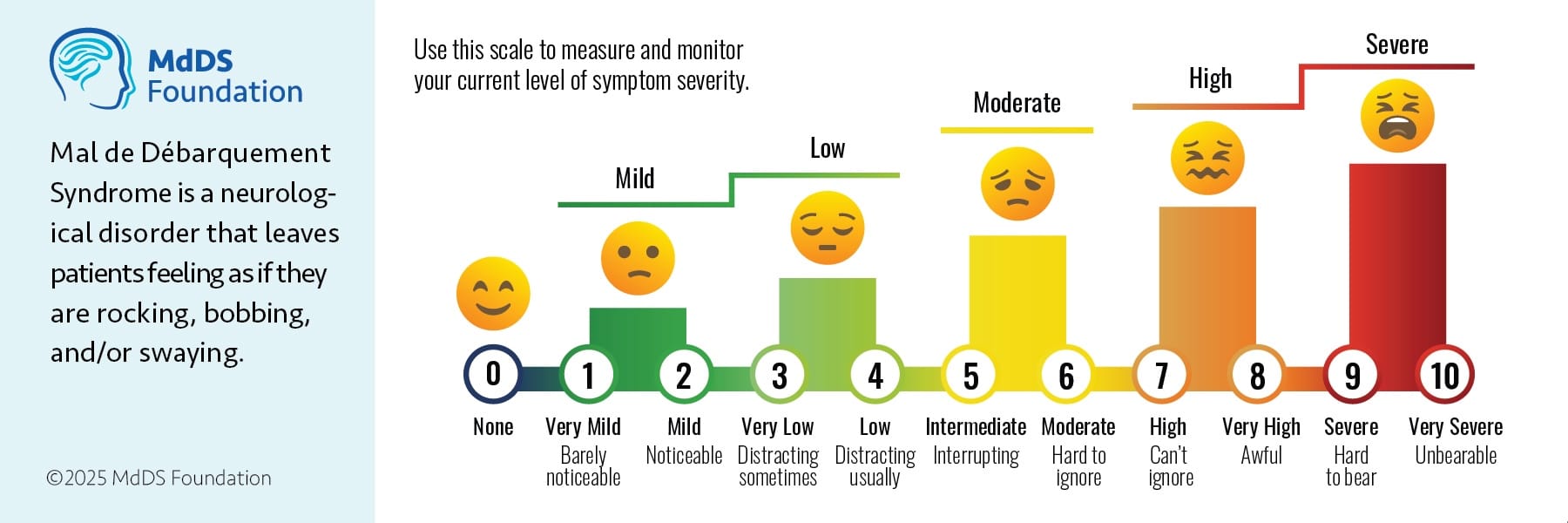Symptoms of MdDS
- MdDS patients perceive rocking, swaying, bobbing, or pulling movements in the absence of actual motion.
- MdDS is typically triggered after prolonged exposure to passive motion: cruise ships, boats, airplanes, cars, or trains. A few describe virtual reality games, water beds, and elevators as triggers. Some suffer with no associated motion event.
- What makes MdDS unique is that MdDS symptoms are relieved when in passive motion, e.g., riding in a car.
- MdDS symptoms may persist for months to years.
Diagnostic Criteria
MdDS can be diagnosed on the basis of patient history as described in a published consensus document by neurotology experts of the Bárány Society:
A. Non-spinning vertigo characterized by an oscillatory perception (‘rocking,’ ‘bobbing,’ or ‘swaying’) present continuously or for most of the day
B. Onset occurs within 48 hours after the end of exposure to passive motion
C. Symptoms temporarily reduce with exposure to passive motion
D. Symptoms continue for >48 hours
Non-motion triggered individuals must meet criteria A, C and D.
Diagnosis Codes
ICD-10-CM: R42, Dizziness and giddiness. Included under syndromes. This code is still used in the USA.
ICD-11-CM (v2025-01): AB31.4, Disembarkment syndrome or Mal de débarquement. Most current version.
NEW IN 2025 — MdDS Symptom Severity Scale

Professionally printed Symptom Severity Scales, quick reference MdDS Knowledge Cards, and our informative brochure (for patients) are complimentary by contacting us.
MdDS-associated Symptoms May Include:
- imbalance
- impaired cognitive function
- fatigue
- headache (including migraine)
Treatment Challenges
- A universally effective treatment for MdDS is not known.
- Medications such as scopolamine or meclizine are not effective in either treatment or prevention of MdDS.
- Medications may provide MdDS symptom reduction and are often determined by trial and error. Benzodiazepines or SSNI/SSRIs may be beneficial.
- Non-pharmacologic therapies include optokinetic (OKN) stimulation with head roll, vestibular physical therapy, and neuromodulation such as with transcranial magnetic stimulation.
- Symptom management includes stress reduction, regular exercise, and rest.
Diagnostic Challenges
- The cause of MdDS is unknown.
- MdDS cannot be diagnosed by imaging or medical testing.
- MdDS may persist for months to years.
- Patient work-up is used to rule out other disorders.
- The average person with MdDS sees a dozen doctors.
- Many people suffering from MdDS are undiagnosed.
- On “dizziness.” While patients may complain of dizziness after air/land/water-based travel or even “spontaneously,” they don’t mean dizzy per se. For lack of a better word they mean to say, they feel as if they are on a boat.
Diagnosing MdDS
MdDS Foundation
4:44 pm
